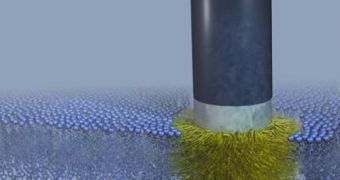A team of scientists has recently developed a new type of nanoscale probe that is capable of seamlessly passing through cellular walls. This ability is tremendously important, especially when considering that it could give investigators in fields such as medicine and biotechnology a new option in “listening” to the electrical activity patterns of single, living cells. The group, which is based at the Stanford University, says that the particles it developed could be used for about a week at a time.
One possible application for the new technology could be its employment in monitoring what is known as “digestive rumbling,” which is basically the electrical activity of cells in the human gut, as they react to drugs a person ingested. Additionally, via the same method, scientists could keep track of how cells such as neurons communicate with each other. Studies have in the past revealed that electrical activity played a significant role in the human body, but work to fully understand its operations has fallen short of achieving its goals.
Generally, when this line of investigations is conducted, researchers need to pierce the cellular wall, and then “tune in” to the activity within. Until now, all methods of doing this have been so intrusive and destructive that the cell usually died within a few hours. What the Stanford team did was basically create the first inorganic probe that can seamlessly pierce cellular defenses without causing harmful effect to the target itself. The new work was conducted in the lab of SU assistant professor of materials science and engineering Nick Melosh, PhysOrg reports.
The expert says that the main trait the new probe has is the fact that it can accurately replicate the actions and effects of the cell's natural gateways. “The probes fuse into the membranes spontaneously and form good, strong junctions there. We cannot pull them out. The membrane will just keep deforming rather than let go of the probes,” says Melosh. “What we have done is make an inorganic version of [a] membrane protein, which sits in the membrane without disrupting it. Now we can envision using it for doing our own gate keeping,” he adds. Details of the work are published in the March 30 issue of the journal Proceedings of the National Academy of Sciences (PNAS).

 14 DAY TRIAL //
14 DAY TRIAL //